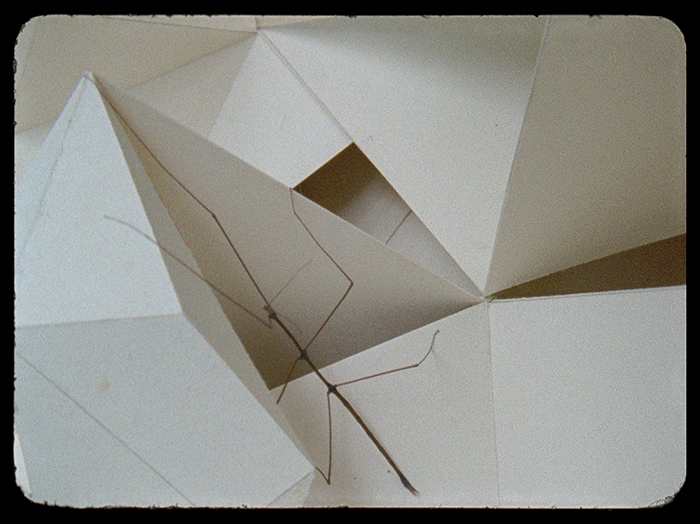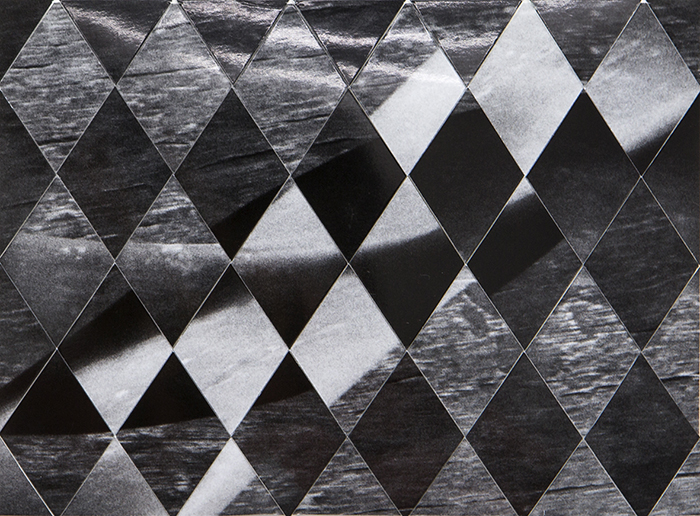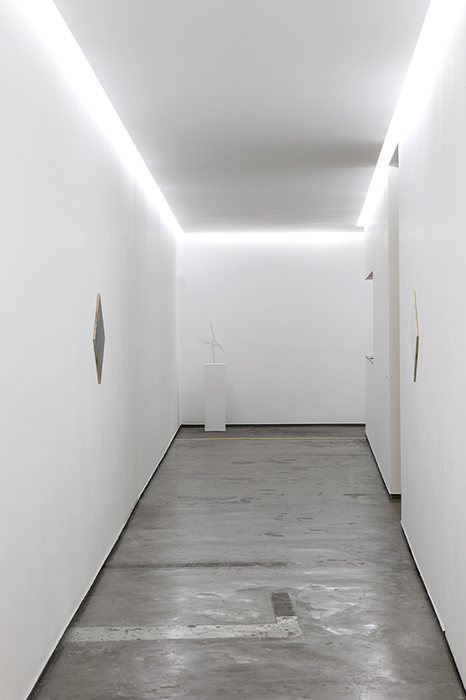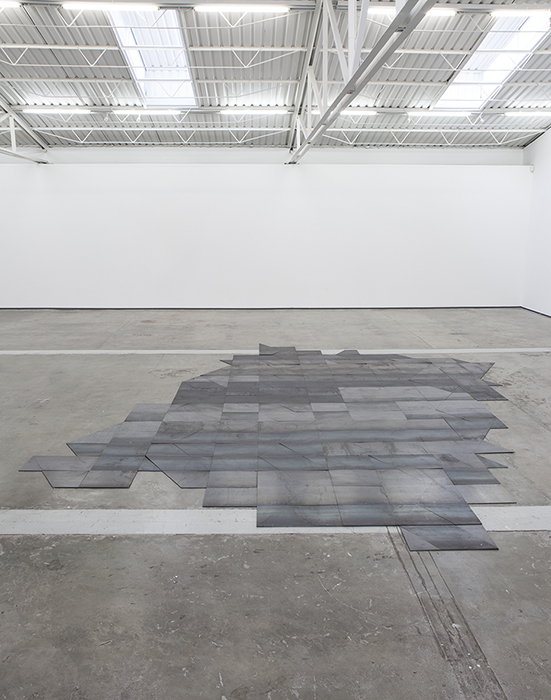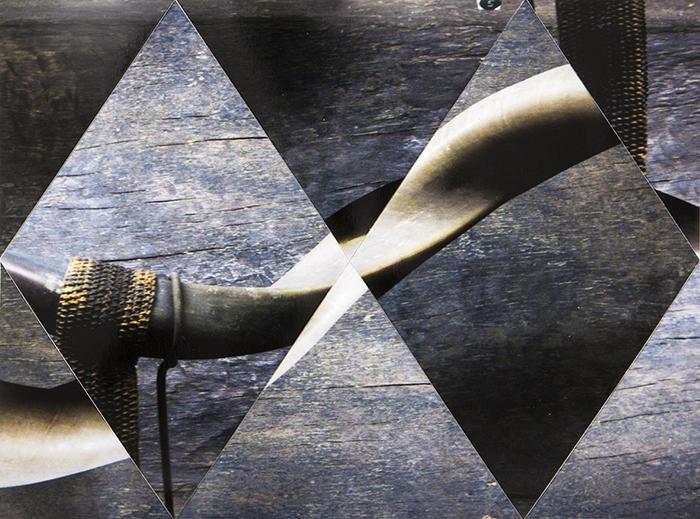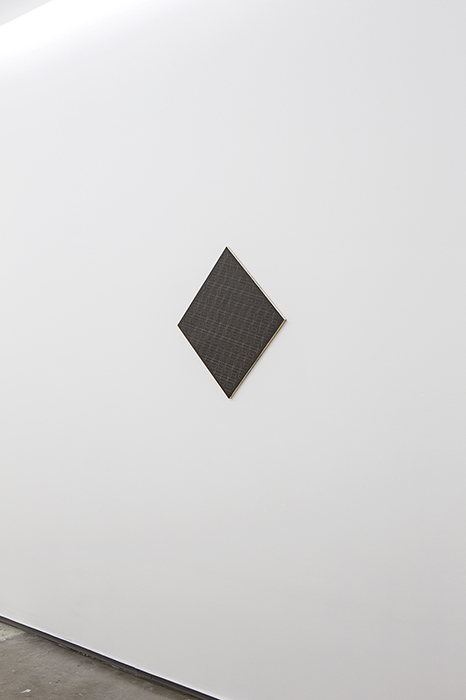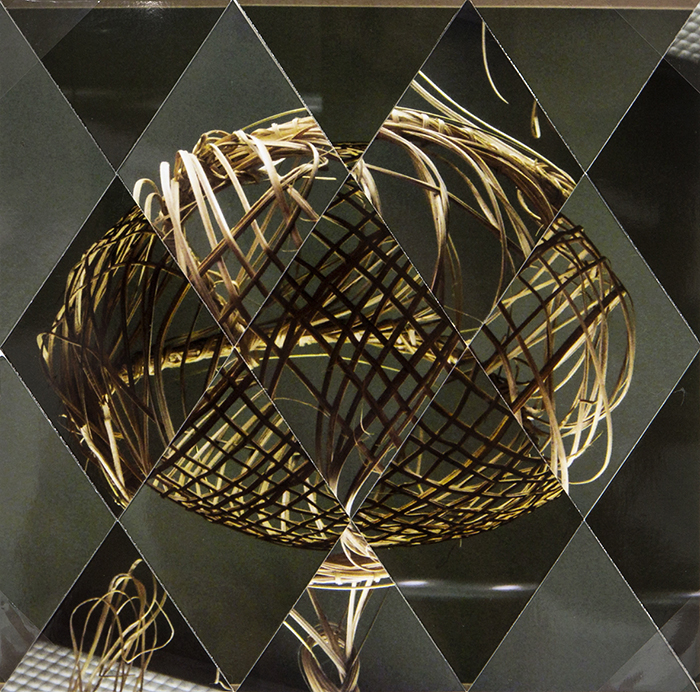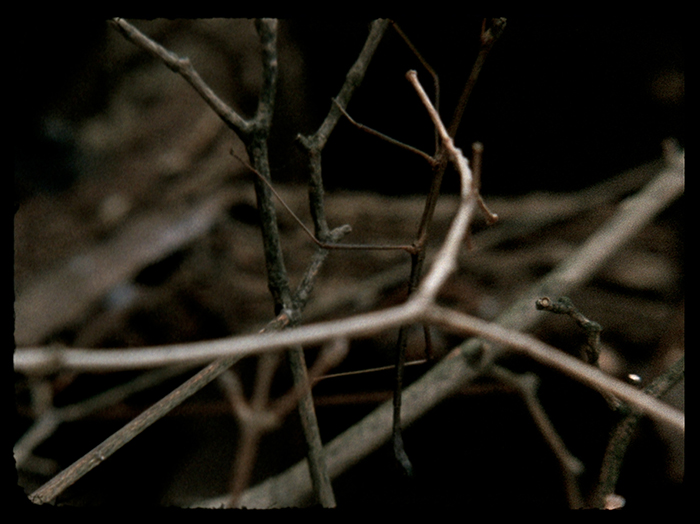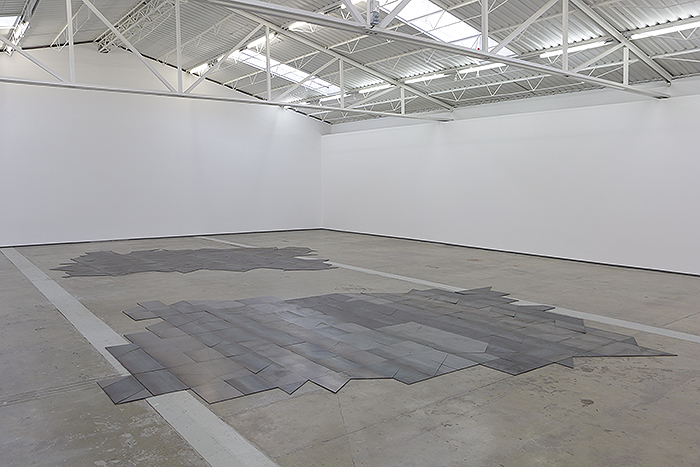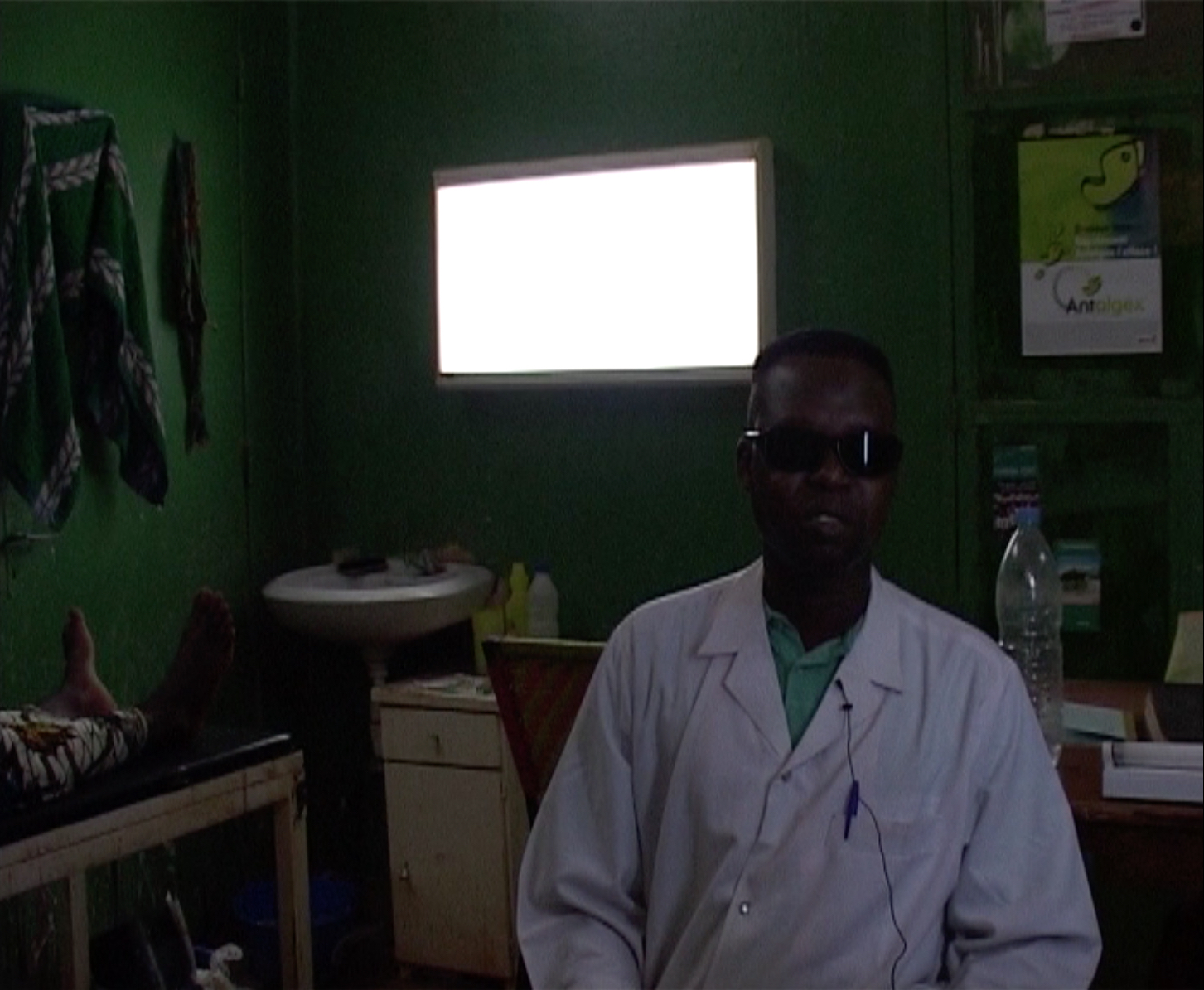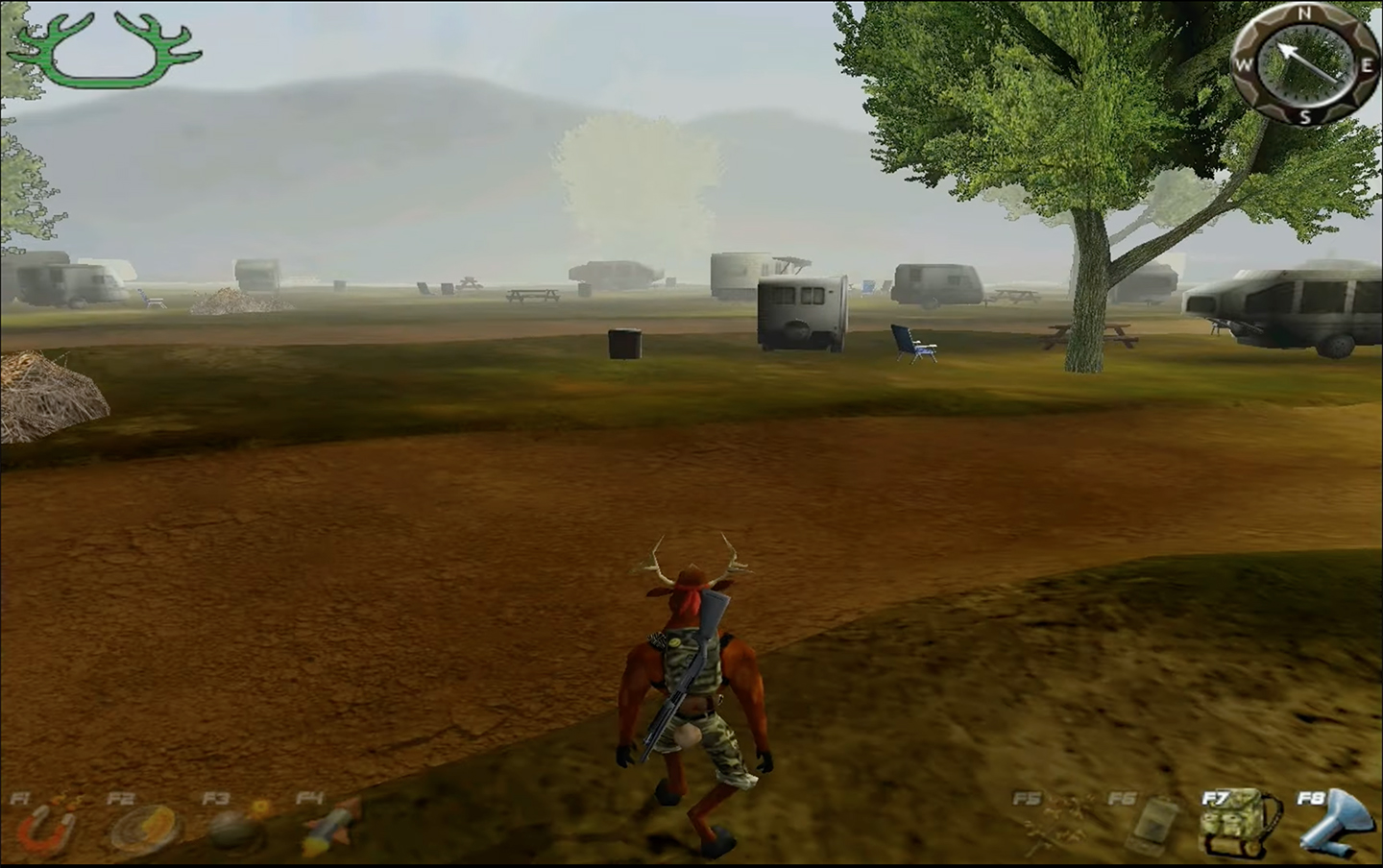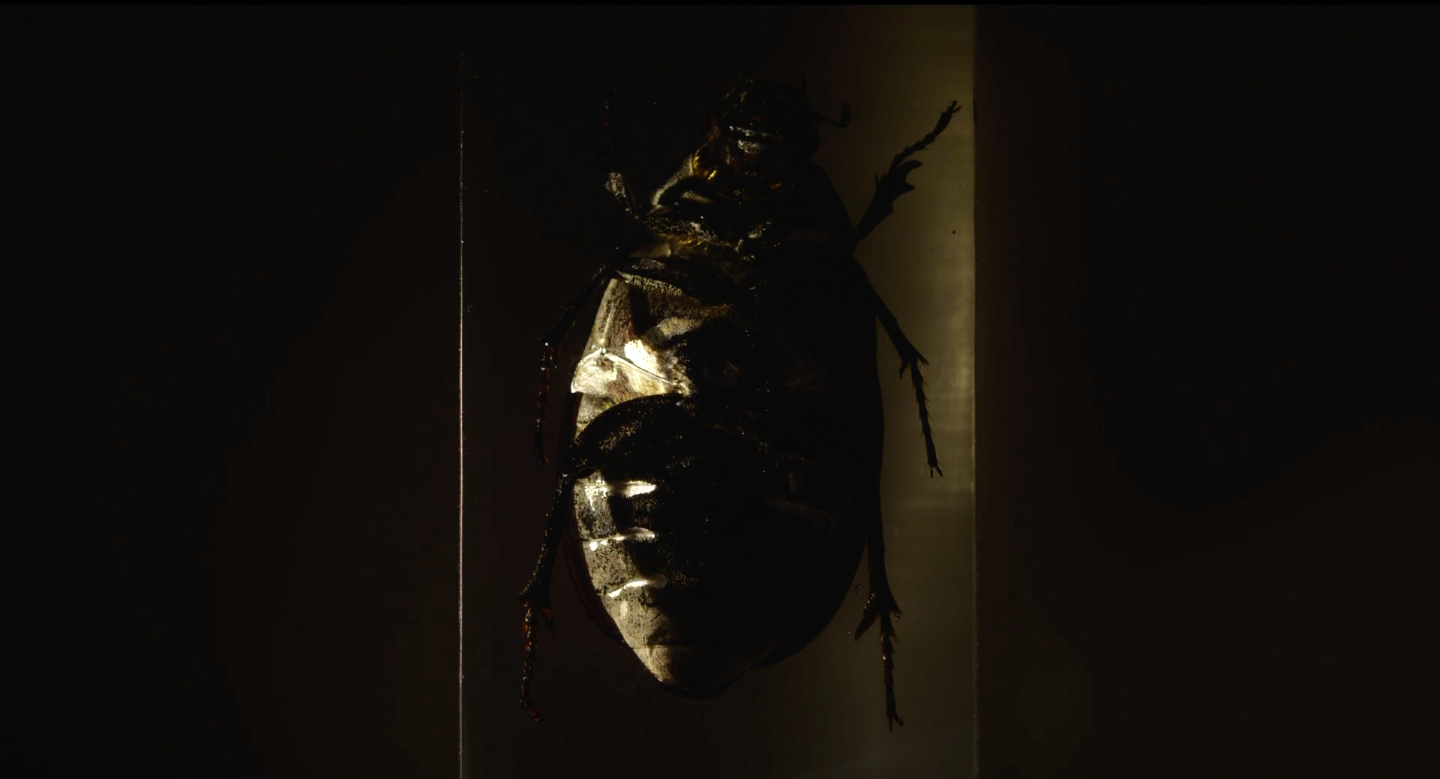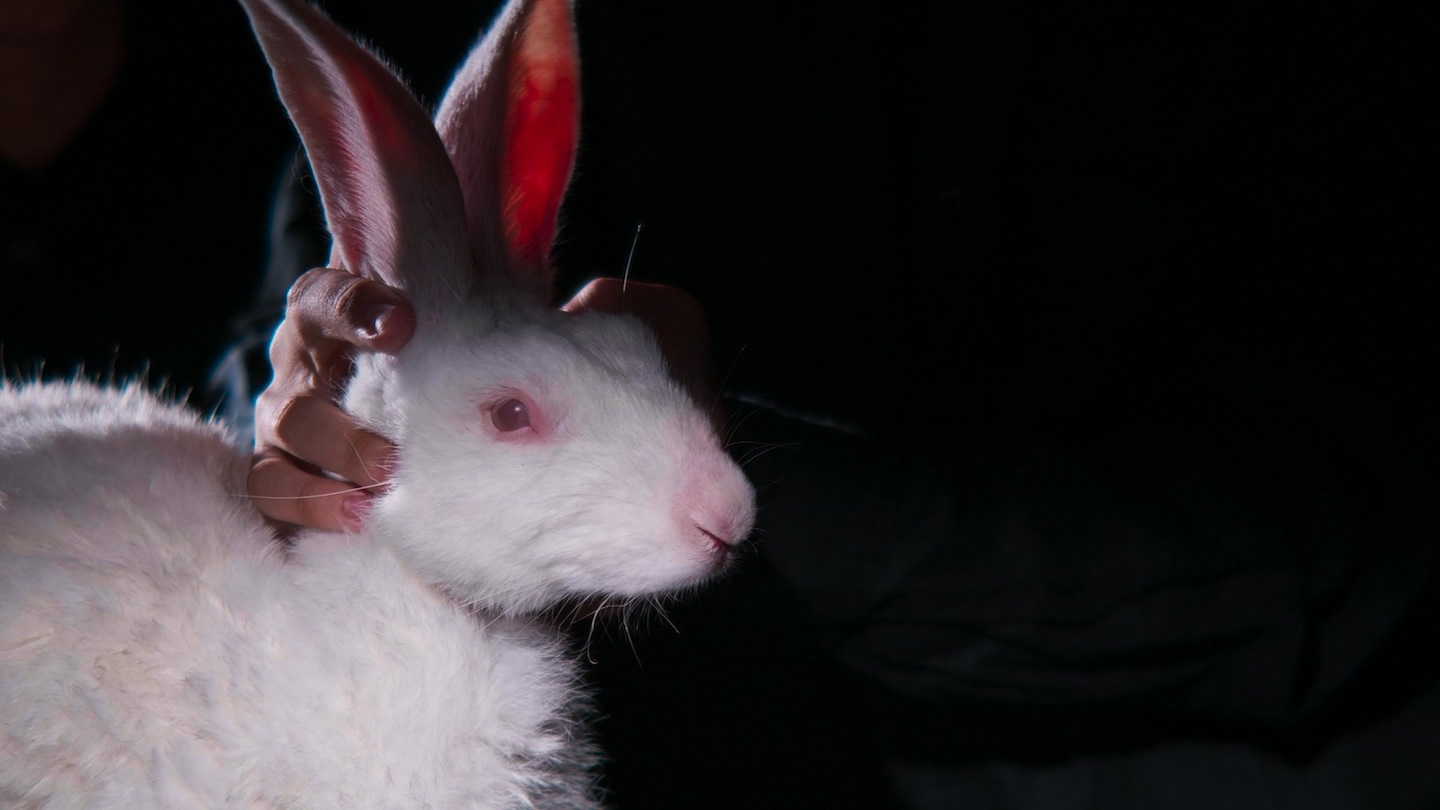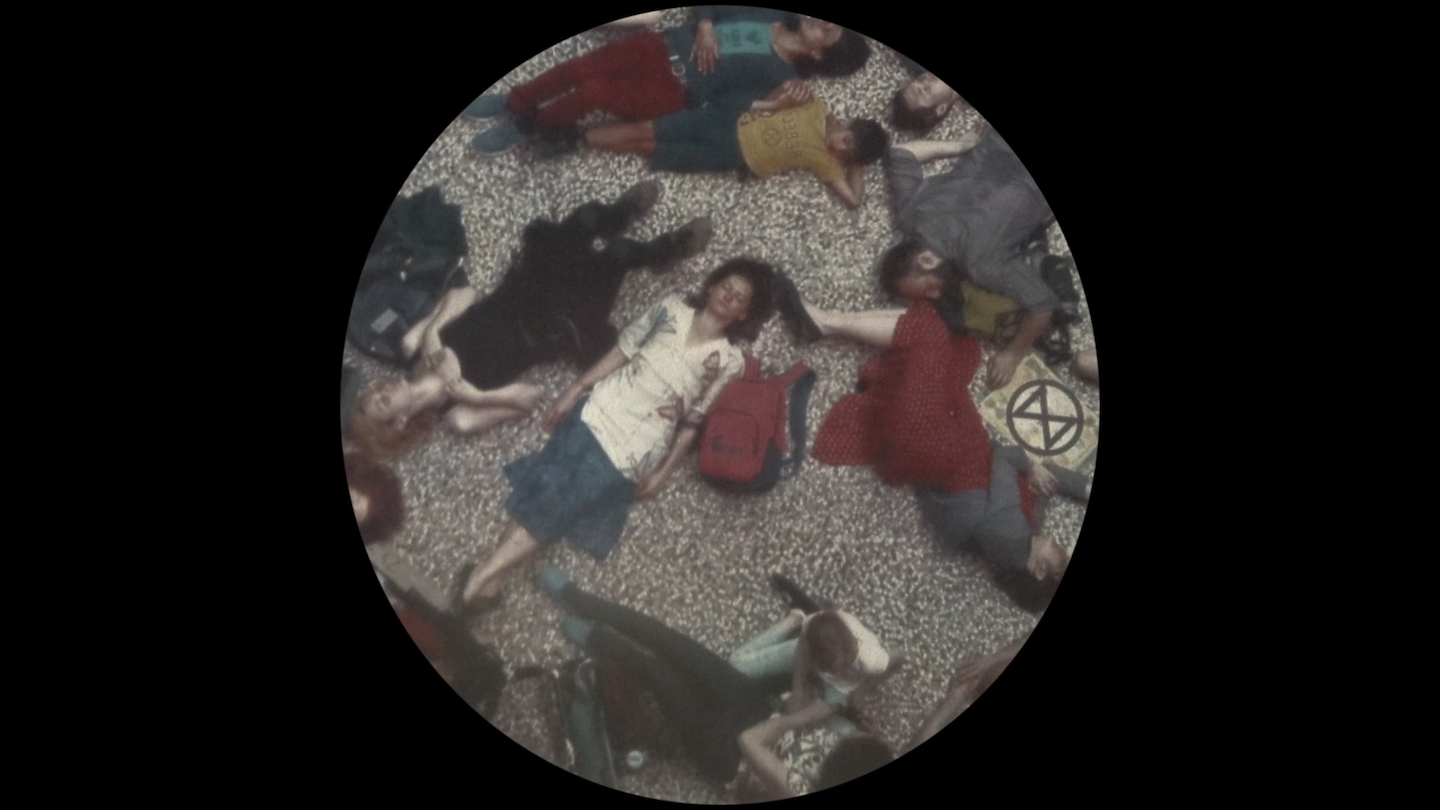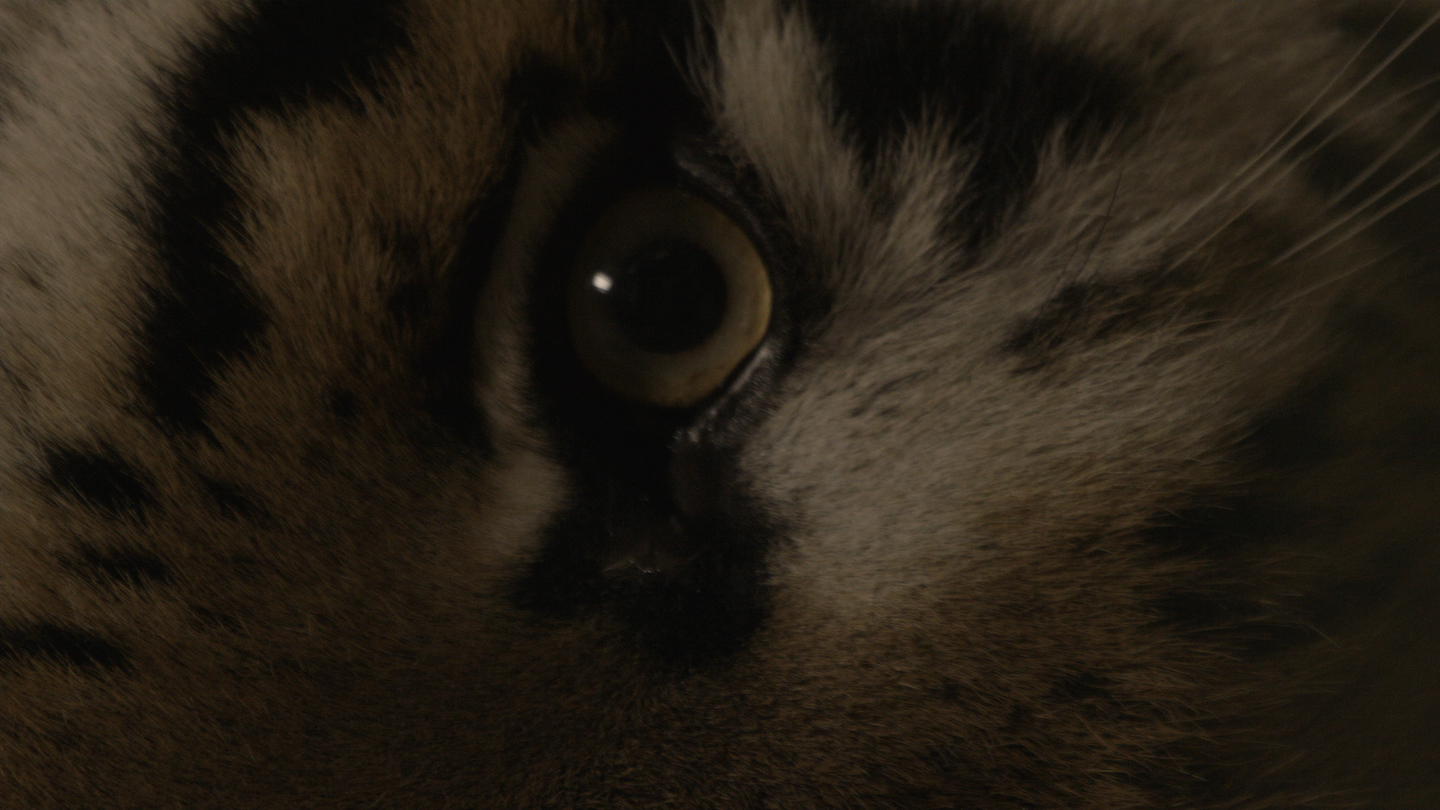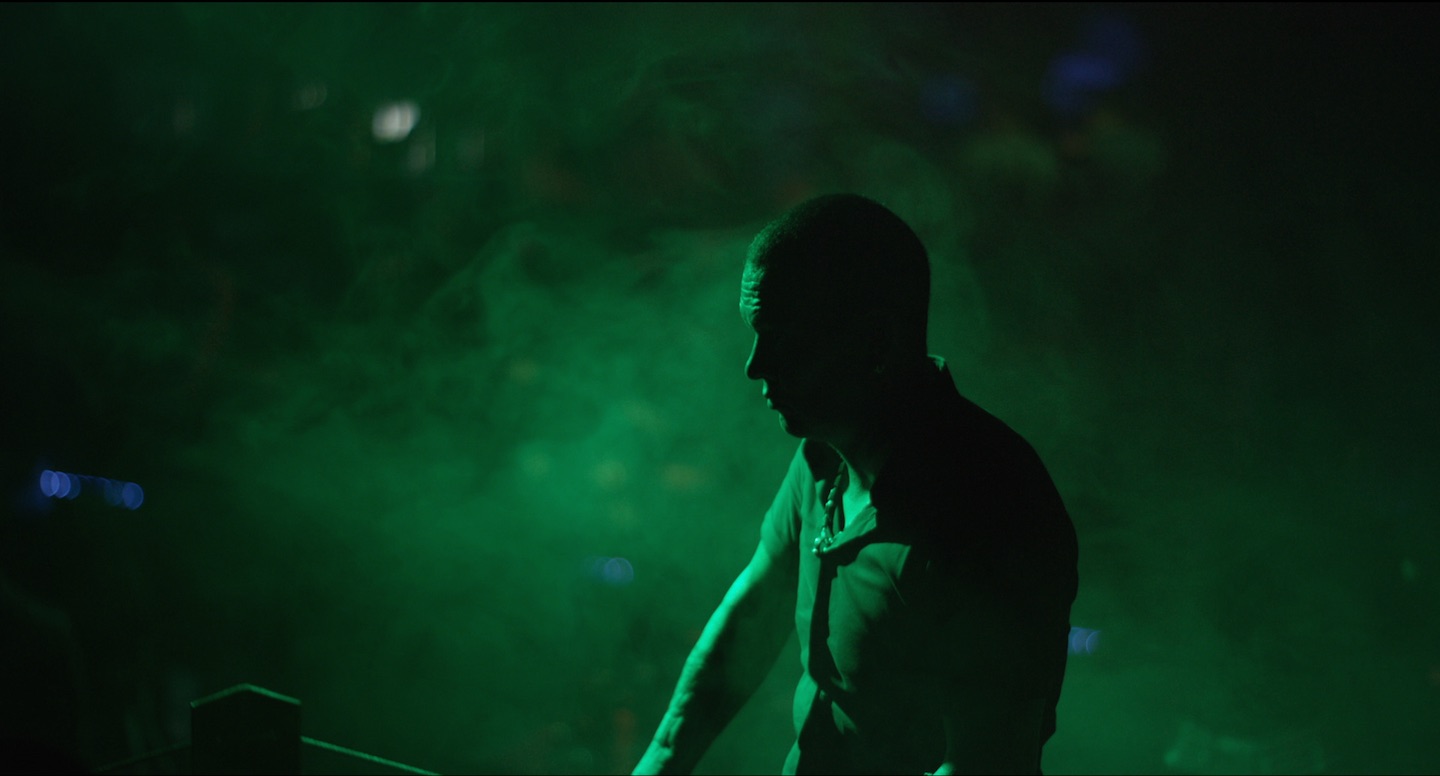June 26–August 30, 2014
The Phasmida are an order of insects whose rocking march always seems hesitant. Every step they take, “stick insects”—as Phasmida are commonly called due to their resemblance to sticks or leaves—will reluctantly stretch out a leg, making cadenced, side-to-side movements as if tentatively rehearsing the next. Biologists will tell you their intention is to remain inconspicuous by mimicking the rustling of twigs, but perhaps they are simply world-weary.
In his 16mm film Phasmides (2012), Spanish-born, Brazilian-based artist Daniel Steegmann Mangrané trails a stick insect’s journey inside his own studio. Initially shot against a cluster of branches and foliage, the insect slowly sways out of its den. It makes its way across the floor and onto a table filled with primary structures and geometric patterns that reflect the formal vocabulary of modern art from Constructivism to Minimalism. Assuming the liveliness of these fixed geometries, the stick insect then blends into a background reminiscent of a Carl Andre or a Sol LeWitt.
Contrary to British naturalists Charles Darwin and Alfred Russel Wallace’s notion of an evolutionary adaptive value, Surrealist writer Roger Caillois described mimicry as a surrender to the “lure of space,” a “scattering of self across landscape,” rather than as a defense mechanism.(1) Whereas Darwinism and psychoanalysis are predicated on autonomy and individuation (for French psychoanalyst Jacques Lacan, the self is a function of the gaze), Caillois attempts to define mimicry as a drive towards depersonalization through assimilation into one’s surroundings. What mimicry achieves morphologically in animal species, Caillois writes, humanity can only experience as an instinct of renunciation that “orients it towards a reduced mode of existence.”(2)
Seemingly passive in its activity, the living insect stands at the intersection between the vegetal, the mechanical, and the mineral—an animate being yearning for the petrified nature of inanimate things. But in the insect’s literal transformation into art in Steegmann’s film, one might also recognize a search for non-intelligent thought and non-human agency. German philosopher G.W.F. Hegel’s “end of art” presupposed the successive dissolution of art forms into the higher form of History, the absolute limit, which signals the moment when reason finds its completion, and mind and matter are fused into a harmonizing whole. Yet, whereas Hegel stated that art was no longer a proper vehicle for humanity’s comprehension of its own essence, the stick insect could very well be illustrating that humanity is no longer a proper vehicle for art’s comprehension of its own essence.
In a sense, one could see object-oriented philosophy and speculative realism as unwittingly announcing this new ontology, but the dialectical entanglement between the animated and the inanimate has been a symptom of the industrial condition since the beginning of the modern era. Modernism was a European export, whose manifestations subsequently remained scarce in Europe, but quickly took hold in South and Central America. Typically made of steel, glass, and concrete, modernist architecture developed in the absence of industry, in what American historian Ramón Gutiérrez calls a “modernism without modernity”; the result was a strange blend of resolve and languor, discipline, and indolence.(3) Functionalism did not represent an apotheosis of the mechanical, but rather an organic synthesis with the immediate environment in which pristine geometries give way to vernacular and ornamental forms.
Combining this ritualized formal obsolescence with a wink to neo-Concretism, Steegmann’s exhibition at Proyectos Monclova stages several works alongside Phasmides, which call for the active participation of his audience. Systemic Grid I and Systemic Grid II (both 2014) are two massive floor pieces composed out of laser-cut, steel hexagons activated by the viewer’s footsteps. Their metallic screech contrasts with the serenity of Ramas de Avenca [Branches of Fern] (2014), two intertwined branches locked into an axial symmetry somewhat akin to the work of Dutch graphic artist M.C. Escher (1898–1972). Echoes of Escher’s influence can be also found in the tessellations of Simetrías [Symmetries] (2014), a series of honeycomb shaped collages.
Much like the Surrealist circles in which Caillois took part, Escher was also interested in the ambiguity between figure and ground. Although he never theorized his quirks of perception as the autonomous subject’s death wish, he shared an affinity with Surrealist themes and their uncanny concern with insect-like intimacy. Then, as now, deceit, assimilation, and trompe-l’oeil effects were not represented as mere survival strategies, but as a surplus or excess of sympathy—the belief that an effect resembles its cause, or that one can influence something based on its resemblance to another thing.
1) Caillois’s “Mimicry and Legendary Psychasthenia” was originally published in 1935 in the Surrealist journal Minotaure. See Roger Caillois, “Mimicry and Legendary Psychasthenia,” [1935] trans. John Shepley, October, vol. 31 (Winter 1984): 28. 2) Ibid., 30. 3) Ramón Gutiérrez as quoted in Mauro F. Guillén, “Modernism without Modernity: The Rise of Modernist Architecture in Mexico, Brazil, and Argentina, 1890–1940,” Latin American Research Review, vol. 39, no. 2 (2004): 6–7.
